Time for plan B… Well, actually somewhere around Plan E or F. Above you see a root of the Nuphar luteola/lutea. If you’ve ever taken one of my foraging classes you have heard me rant about this plant and foraging books. All the books that mention the root say it is edible. I’ve never been about to make it palatable despite years of trying. It’s extremely bitter which had led me to believe writers who say it is edible have never tired it. I know two writers who excluded from their books because they had the same experience as me. It might be time to reassess the root.
First the historical perspective: Nowhere else on earth was a plant in this genus reported as edible except in North America. But that is a fuzzy fact for two reasons. The first is there were clearly different species. Botanists were in denial of that reality for centuries. The second is we have one centuries-old report that the natives ate the root after “long boiling” and that it tasted like sheep’s liver. Sheep’s liver would be a fantastic improvement over what it tastes like naturally. So, we aren’t quite sure which Nuphar root the native were cooking up nor beyond boiling what they might have done to it. Complicating the issue is the fact that what was once a bunch of variations within one species is now many species with here-today gone-tomorrow scientific names. It is possible there was a Nuphar luteola/lutea in Maine that was same in name in Florida and Oregon but was a different species and edible. That’s iffy because no matter what you call the plant — in North America or Europe — no one actually seems to eat it though one can find it everywhere… assuming the “it” is the same species. It is one of the most common uncommonly eaten edibles.
Starting in 2002 and up until I moved last fall I grew N. luteola/lutea in my backyard in a water-controlled pond. I got the starter plant from the Wekiva River. It had a wholesome life and was not sitting in tannic water all the time. As I say in my classes I tried everything I could think of over the years to make the root edible. I diced and soaked it for a week, changing the water as one does with acorns to reduce the acid load. I did the same for a month, changing the water daily. I simmered it for a week. Yes, a full week. I salted it. I dried it. I fried it. I baked it in the sun ending up with tough, bitter styrofoam-like lavender plugs. Nothing worked which is a bit frustrating because it has the feel of eggplant and is easy to work with. The root looks like it should be edible. As I jokingly have said in my classes for many years I tried everything but fermenting.
Fermenting… As of late I have been delving into lacto-fermenting vegetables. There are reports that such fermenting can reduce the tannic acid load of some foods. Maybe the joke was closer to the truth than I knew. What if they boiled long-fermented roots? Perhaps there was a selection process for the root, or they were fermented someway before cooking that the original reporter was not aware of. And while I don’t want this to sound like a “dumb” moment the edible seeds are bitter, too. But, letting the seed soak for three weeks in water you don’t change — while the pods rot — makes them edible. Perhaps a solution was always there for the root: fermenting them. It’s on my list of things to do.
The Simpson Stopper is an odd shrub. It’s had over two dozen names because botanists can’t quite figure out just where it fits in the shrub world. It’s also a native and an up-and-coming landscape plant. Another odd thing about the multi-named shrub in that it has three types of leaves. In the picture to the left you can see three leaf tips; dimpled, round and pointed. These can be found on the same shrub.The leaf of the Simpson Stopper is also covered with dots. Under a #10 loop the upper surface of the leaf looks like it is covered with tiny drops of water (the dots.) The underside of the leaf is often decked out in what appears to be very tiny green dots, sometimes blackish dots. If you hold the leaf to the light and use a loop you will see gold dots. The leaves can also curl under at the edge.
Because of the effort to use more native plants the Stopper is seen more now than it used to be. Most landscaping locally includes one and they are also used for hedges. The orange to red fruit is often in pairs and has a little four-sided round pucker at the end (kind of like a little folded-in blueberry crown made of four triangles.) The closely related Syzigums have a wrinkled cross at the end of the fruit. The Stopper fruit has one or two bean-shaped seeds, two being more common, often stuck together. The flavor of the very ripe fruit is close to marmalade or sweet orange rind. Because of taste the seeds are not edible. They taste like unripened Surinam Cherries, which the Stopper is closely related to. They are blossoming now.
Foraging Instructors: What many people don’t know is EatTheWeeds is also the location of the oldest and most comprehensive list of foraging instructors in the world on the internet. While most of the teachers are in North America Europe is well represented. The beginning of the list started on paper in the early 90s. Since 2008 it has been on EatTheWeeds and greatly expanded to now well over 100 teachers. Continuing efforts are made to keep the list’s information contemporary. If you know of any updates please let me know. To find the list type Foraging Instructors in the search window or find a drop down menu on the home page under the word Foraging at the top of the page. As for the goat… When for various reasons I don’t have a picture of the instructor I substitute one of a foraging goat from a peninsula in Crete. The area there is quite barren and even the tops of occasional trees are free foraging game. (Because the page has some persistent formatting issues that I think are more related to Word Press than me I save up instructor additions to the list for a one-evening battle with the computer every few months. If you have been waiting to be listed, my apologies. I should be up-to-date.)
This past week I held foraging classes in Cassadaga and Ocala. There is perhaps no better time locally to be looking for wild edibles. The weather has not turned summer hot and there’s a lot to be found. It’s much easier to go looking for some of the 7% edible species than trying to identify the 93% that aren’t edible. Of particular interest was finding a mixture of last winter’s plants with the beginning of summer species. Ending their seasonal run is Pellitory and Chickweed. At blossoming stage we found Heart Leaf Sorrel and Wild Garlic both quite easy to spot. In Cassadaga we saw a banana blossoming and Kudzu was sending out its controversial shoots. We even dug up a Florida Betony root. It is still too early to find wild yam vines. They’ll wait another two to six weeks depending upon the weather before sprouting. But, you can find their general location by looking for their odd “air potatoes” hanging off shrubs and trees. We don’t eat the “air potatoes” but we use them to find and identify the tasty root.
My Foraging Class Schedule:
Sunday, April 5th, Bayshore Live Oak Park, 23000 Bayshore Rd., Port Charlotte, FL 33980, 9 a.m.
Saturday, April 11th, Red Bug Slough Preserve, 5200 Beneva Road, Sarasota, FL, 34233, 9 a.m.
Sunday, April 12th, Mead Garden, 1500 S. Denning Dr., Winter Park, FL 32789. 9 a.m.
Saturday, April 18th, Spruce Creek Park, 6250 Ridgewood Ave. Port Orange, 32127, 9 a.m.
Sunday, April 19th, Florida State College, south campus, 11901 Beach Blvd., Jacksonville, FL, 32246, 9 a.m. To
To learn more about classes, go here.
On the Green Deane Forum we chat about foraging all year long. And it’s not just about warm-weather plants or just North American flora. Many nations share common weeds so there’s a lot to talk about. There’s also more than weeds. The reference section has information for foraging around the world. There are articles on food preservation, and forgotten skills from making bows to fermenting food. Recent topics include Heliculture, Tincture? What Kind of Weeds? Sassafras, Cherry Bark Tea, Biting Bugs, Firebow Tinder, Sheep Sorrel, Brown Bear and Greens, Homemade Sauerkraut, Coconut Oil, Solanum sisymbrifolium seeds, Lost resource Armadillos and Leprosy, Sprouting Palm Seeds, Plant Sources for Camphor, and What Do You See #20. You can join the forum but clicking on the button on the upper right hand side of this page.
What Do You See #21. This week it is easy. There are two edible species in the picture. What are they? Last week the edibles were Poor Man’s Pepper Grass, Sow Thistle, and Henbit. 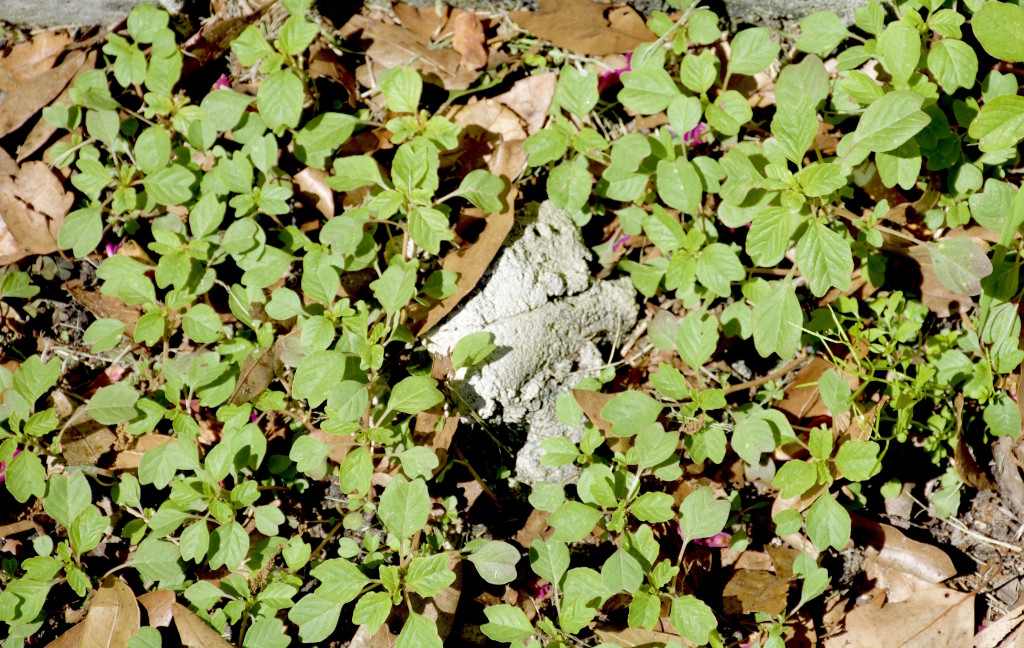

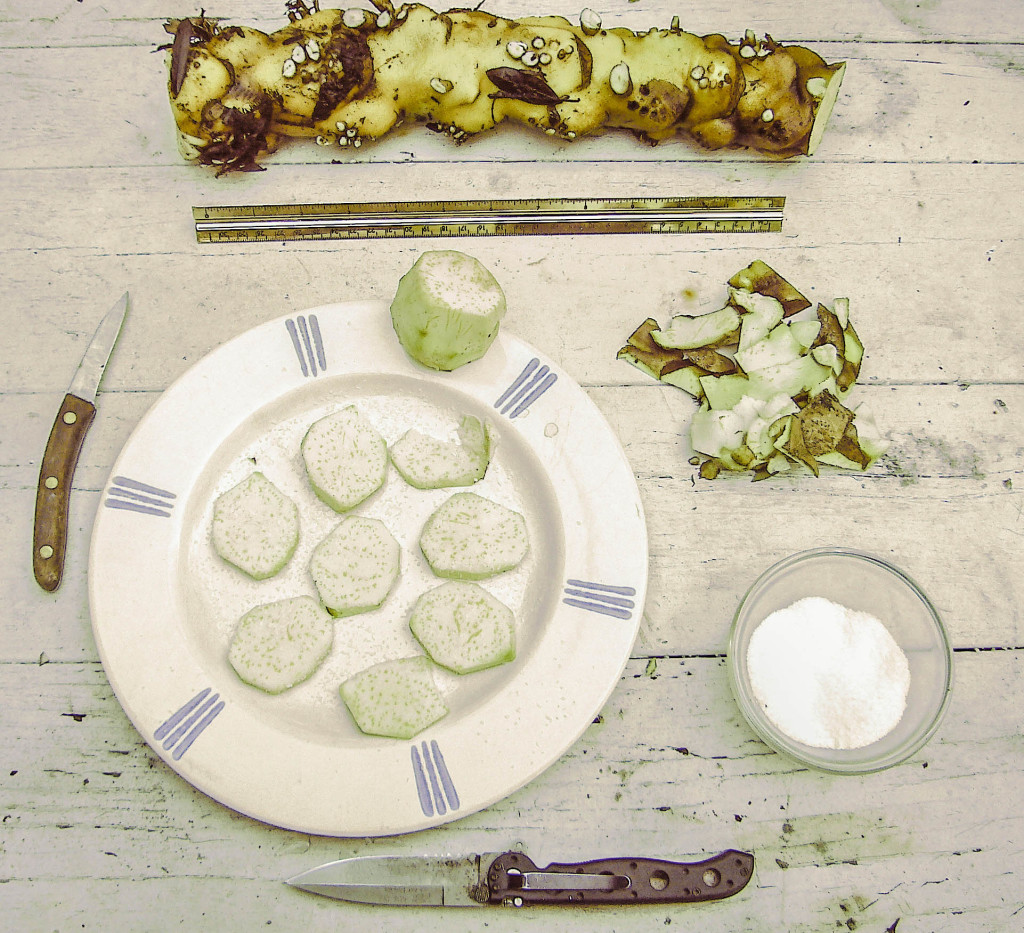
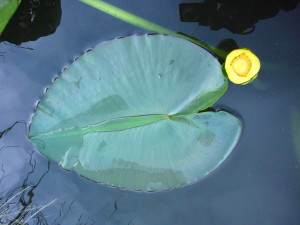
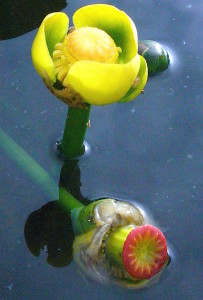
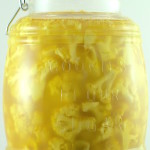
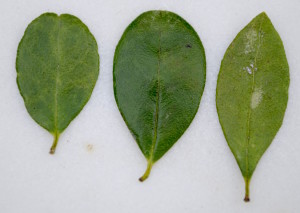
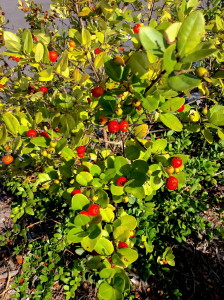

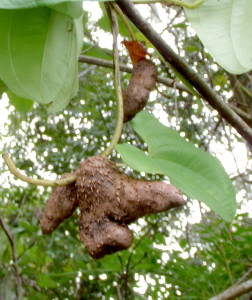



Easy? Maybe for you Flordians… I have never seen that plant in my life, but I’m guessing it’s some type of amaranth. I have never seen an amaranth with notched leaves like that though. The other one is common here in east Texas, bittercress.
“Notched” amaranth is very common in North Ameriac
The native Nuphar in Florida is Nuphar advena, also called Spatterdock.
It is now, but there are some who would argue that (not I.)
Red Root Pigweed ?(Yes, an amaranth.)
Now Deane, you’re not disparaging sheeps’ liver, are you?
Seriously, liver from a wide range of animals used to be a highly favored food, and was widely eaten until just a few short (relatively speaking) years ago. Maybe not so much from feedlot or confinement reared animals fed a diet unnaturally high in grains with synthetic chemical residues… organ meats from well-reared or wild animals that are well prepared are both delicious and exceptionally nutritious. Lamb and sheep liver are still enjoyed by many millions around the world – so if the root of this Nuphar lutea tasted like sheep liver, when properly prepared, it must have been well worth the effort.
That said, it seems a strange flavor for a root to resemble. We eagerly await the results of your ongoing experiments with this root.
Actually I like liver though I must admit I have not had sheep’s liver.
Hmmm. In that photo, I think I see wild amaranth and maybe some pellitory.
There is Amaranth, which is most of the plants there. But that little one on the right isn’t Pellitory.
Deane, I have no clue about the eventual palatability of your experimental fermentation of the Nuphar lutea root, but in my fermenting adventures I’ve learned that some few things are better cooked first and then fermented. If you could tone it down some with cooking, maybe the fermentation will work even better? Try it both ways? Let us know, I love experiments in the kitchen la-borah-tory! I always seem to have something “brewing”…just not beer….yet!
Unlike the Nuphar lutea root, my Cassava’s (Manihoteae esculenta – locally called “buffra” ) is certainly an edible starchy tuberous root, easy to process though a bit of cyanide should be taken in consideration. Last week I obtained about 5Kg. of this root and enjoyed the pudding and thick aquous drink with sugar and sometimes vanilla flavoured as part of my diet during the week. I think I’ve felt stronger.
Back to Nuphar lutea, some people here call it “zinbug elma’a” or flower of water; they also call it “Bee killer” assuming by folding its leaf once a bee is approaching, results in its death. Among many other medicinal uses of the root of Nupar lutea , my people are interested to use the aquous extract to treat sex irritability as you’ve mentioned for the case of the Indians tribes.
As for the sheep’s liver taste, I think it is mainly due to the root being rich in polyamines. By the way, I for one among many of my people here in Sudan, had eaten lamb’s liver in my youth – how delicious raw, fresh, with red chilli , lemon juice, onions and pea nut paste. It is also enjoyable when semi fried with vegetable oil and some tomato paste added lastly. Not only that ;but raw camel liver is also favoured by my people – strong teeth required. If cooked, the latter becomes more hard to bite.
You’ve talked about liver taste. During my reading on polyamines I’ve come across reports on a tree – Pyrus calleryana – described as emitting during flowering stage – may be these days in some places – pungent, often unpleasant smell, which has been described as reminiscent of rotting fish, chlorine or human semen. Others spoke of ”bleachy”, or the smell encountered in swimming pools. My interest is due to the fact that I do share the same description of a smell I obtain from a weed – annual – I’m taking care of it and now collecting the very tiny brown seeds with the purpose of further investigation and identificaton – many ants are doing the same seeds being edible in their case.